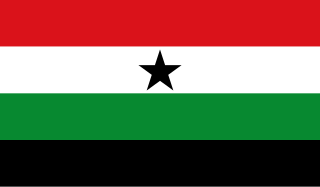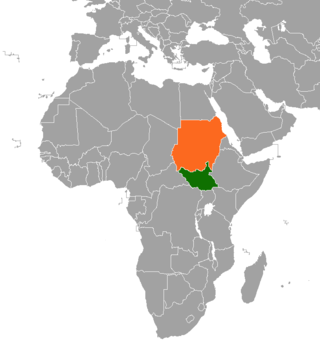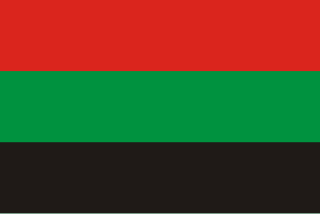
The Luo, are several ethnically and linguistically related Nilotic ethnic groups that inhabit an area ranging from Egypt and Sudan to South Sudan and Ethiopia, through Northern Uganda and eastern Congo (DRC), into western Kenya, and the Mara Region of Tanzania. Their Luo languages belong to the western branch of the Nilotic language family.

Jonglei State is a state of South Sudan with Bor as its centre of government and the biggest city. Jonglei state comprises nine counties: Bor, Akobo, Ayod, Uror, Duk, Nyirol, Pigi, Twic East, and Fangak. Jonglei State is the largest state by area before reorganisation, with an area of approximately 122,581 km2, as well as the most populous according to the 2008 census conducted in present-day South Sudan's second period of autonomy. The boundaries of the state were again changed as a result of a peace agreement signed on 22 February 2020.

The Gambela Region, officially the Gambela Peoples' Region, is a regional state in western Ethiopia, bordering South Sudan. Previously known as Region 12, its capital is Gambela. The Region is situated between the Baro and Akobo Rivers, with its western part including the Baro River.

The Anyuak, also known as Anyuaa and Anywaa, are a Luo Nilotic ethnic group inhabiting parts of East Africa. The Anuak belong to the larger Luo family group. Their language is referred to as Dha-Anywaa. They primarily reside in the Gambela Region of western Ethiopia, and South Sudan. Group members number between 200,000 and 300,000 people worldwide. Many of the Anyuak people now follow Christianity. It is one of the first of the Nilotic groups to become almost entirely Christian, following the Shilluk people.

The Murle are a Surmic ethnic group inhabiting the Pibor County and Boma area in Greater Pibor Administrative Area, South Sudan, as well as parts of southwestern Ethiopia. They have also been referred as Beir by the Dinka and as Jebe by the Luo and Nuer, among others. The Murle speak the Murle language, which is part of the Surmic language family. The language cluster includes some adjoining groups in Sudan, as well as some non-contiguous Surmic populations in southwestern Ethiopia.

Administrative Zone 3 is a former administrative subdivision of the Ethiopian Region of Gambela. This zone was bordered by Sudan on the south, west and north, by Administrative Zone 1 on the east and Administrative Zone 2 on the southeast; the Pibor defines the border on the south and west, while the Baro defines it for the northern border. Towns in this zone included Tergol and Telut. Most of the area of this zone was added to Nuer Zone and some parts were added to Anuak Zone.
Jor is a woreda in Gambela Region, Ethiopia. Part of the Anuak Zone, Jor is bordered on the south by the Akobo River which separates it from South Sudan, on the west and north by the Nuer Zone, on the northeast by Abobo, and on the east by Gog; the Alooworro River defines part of its northern boundary. The administrative center of this County is Ongoogi.
Itang is a woreda in Gambela Region, Ethiopia. Because Itang is not part of any zone in the Gambela Region, it is considered a Special woreda, an administrative subdivision which is similar to an autonomous area. It is bordered on the south and southeast by the Anuak Zone, on the west by the Nuer Zone, on the northwest by South Sudan, and on the north by the Oromia Region; part of the southern boundary is defined by the Alwero River. The major town in Itang is Itang.
Akobo is a woreda in Gambela Region, Ethiopia. It is named after the Akobo River, which flows westwards then north into the Baro River, defining its border with South Sudan. Part of the Nuer Zone, Akobo is bordered on the south and west by South Sudan, on the north by Wentawo, and on the east by the Anuak Zone. The westernmost point of this woreda is the westernmost point of Ethiopia. Towns in Akobo include Tergol.
Jikawo is a woreda in Gambela Region, Ethiopia. Part of the Nuer Zone, Jikawo is bordered on the south by the Anuak Zone, on the west by the Alwero River which separates it from Wentawo, on the north by the Baro River which separates it from South Sudan, and on the east by Lare. Towns in Jikawo include Nginngang and Telut.

The Gambela conflict refers to sporadic conflicts in the Gambela Region of Ethiopia between armed groups of the indigenous Anuak people with armed groups of the Nuer people, and the Ethiopian military. Following resettlement policies implemented by the Derg regime in the 1980s, a number of ethnic conflicts have taken place between the Anuak people indigenous to much of the Gambela region, and other groups which were resettled in the region. Following the collapse of the Derg regime, persistent ethnic tensions in the region have occasionally exploded into open conflict. Such conflict erupted in the early to mid 2000s, coinciding with an increase in petroleum extraction in the region, and led to a number of incidents resulting in the large-scale deaths of civilians. The Ethiopian military has intervened to combat Anuak militias.

Akobo, is a town in South Sudan.
Pochalla is a town in South Sudan.

Sudanese nomadic conflicts are non-state conflicts between rival nomadic tribes taking place in the territory of Sudan and, since 2011, South Sudan. Conflict between nomadic tribes in Sudan is common, with fights breaking out over scarce resources, including grazing land, cattle and drinking water. Some of the tribes involved in these clashes have been the Messiria, Maalia, Rizeigat and Bani Hussein Arabic tribes inhabiting Darfur and West Kordofan, and the Dinka, Nuer and Murle African ethnic groups inhabiting South Sudan. Conflicts have been fueled by other major wars taking place in the same regions, in particular the Second Sudanese Civil War, the War in Darfur and the Sudanese conflict in South Kordofan and Blue Nile.

Wentawo is one of the woredas in the Gambela Region of Ethiopia. Part of the Nuer Zone, Wentawo is bordered on the south by Akobo, on the west and north by South Sudan, on the east by Jikawo, and on the southeast by Anuak Zone; the Akobo River to the west and the Baro River on the north define Wentawo's boundaries with South Sudan. Towns in this woreda include Metar.
Ethnic violence in South Sudan has a long history among South Sudan's varied ethnic groups. South Sudan has 64 tribes with the largest being the Dinka, who constitute about 35% of the population and predominate in government. The second largest are the Nuers. Conflict is often aggravated among nomadic groups over the issue of cattle and grazing land and is part of the wider Sudanese nomadic conflicts.

The Gambela People's Liberation Movement was a rebel group in the Gambela Region in Ethiopia. The GPLM was founded by Anuak dissidents during the Derg and Woyane regime. The organization remained dominated by Anuaks. Agwa Alemu was the chairman of the GPLM.
Nuer Zone Amharic Thok Naath, The Zone is founded in Gambela Region of Ethiopia. It was created from former Administrative Zone 3, Gambella Region. Location The zone it's located in western Gambella Town is bordered by South Sudan, on the Northern Baro River, Western Pibor, and Southwestern Pibor River, on the east by Itang Special Woreda, on the South-East by Anuak Zone. The administration town called Nyinenyang, also have five administrator woreda Kuergeng Town, Kuach Thiäng Town, Nyinenyang Town, Matar Town and Tiergol Town. Nuer Zone is within the Ethiopian lowlands and is flat at an elevation between 400–430 meters above sea level. The zone consists of grasslands, marshes and swamps with some forests. The economy is predominantly based on livestock. In 2006, there were no agricultural cooperatives, no documented roads, and little other Reference infrastructure. Both Jikawo and Akobo woredas are flooded during the rainy season, requiring the people to migrate to the highlands with their cattle until the waters recede; thus raising livestock is the primary source of income in this Zone.

The Greater Pibor Administrative Area is an administrative area in South Sudan.

Boma State was a state in South Sudan that existed between 2 October 2015 and 22 February 2020. It was located in the Greater Upper Nile region and was formerly part of the state of Jonglei. The state bordered Akobo State, Imatong State, Jonglei State, Kapoeta State, Bieh State, Terekeka State and the country of Ethiopia to the east.











